![]()
![]()
![]()
Use LEFT and RIGHT arrow keys to navigate between flashcards;
Use UP and DOWN arrow keys to flip the card;
H to show hint;
A reads text to speech;
67 Cards in this Set
- Front
- Back
|
Freudian theory: EGO |
ego is the part of the mind that controls rational thought
Negotiates a way for people to meet their biological needs without putting themselves at risk of violating society's expectations |
|
|
Erikoson's ego development theory |
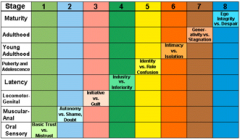
Proposes that the ego matures throughout life as the individual faces bio, psycho, social forces. Involves eight crisis stages - not limited to age. Defined each development point in terms of a push or pull that leads the individual toward an outcome |
|
|
Loevinger's ego development theory |
Ego is personality structure that attempts to synthesize, master, and interpret experiences. Regulates impulses, relates to others, achieves self understanding, and thinks about experiences |
|
|
In what stage of loevingers development theory are most adults? |
Conscientious - conformist Internalized sense of right and wrong, aware of own motives and those of others |
|
|
What are the stages of Loevingers development theory? |
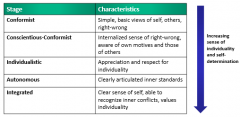
|
|
|
Vaillant's ego development theory |
Focuses on defense mechanisms and how they change in adulthood Ego integrates inner and outer reality reality |
|
|
Compare vaillant's theory to freuds |
Same: defense mechanism subconscious, unaware, to protect ego Different: vaillant believed that defense mechanisms are present all through life but changes as we grow |
|
|
Categories of defense mechanisms |
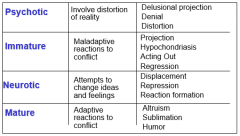
|
|
|
Denial |
Disclaiming feelings or events that actually happened This is different from repression |
|
|
Delusional projection |
Pushing own bizarre feelings onto others |
|
|
Distortion |
Altering reality to protect ego |
|
|
Projection |
Projecting personal feelings onto others i.e. "everyone hates him!" |
|
|
Hypochondriasis |
Psychological conflict with exaggerated physical symptoms |
|
|
Acting out |
Engaging in destructive behaviour that expresses inner conflict |
|
|
Regression |
Primitive coping/ childish behaviour I.e sucking thumb |
|
|
Displacement |
Channeling anger onto "safer" object |
|
|
Repression |
Forgotten troubling event, may be able to acknowledge |
|
|
Reaction formation |
Reacting opposite of true feelings |
|
|
Altruism |
Turning unacceptable feelings into behaviour that is helpful to others |
|
|
Sublimation |
Protecting conflicting feelings in a productive way |
|
|
Humor |
Being able to laugh at an unpleasant or disturbing feeling or situation |
|
|
How do the defense mechanisms differ between age groups? |
Older adults: more mature defense mechanisms, control negative emotions, put situation in perspective Younger adults: acting out, projection, or regression |
|
|
Adults attachment theory |
Proposes that the early bond between the infant and caregiver sets the stage for all of the individuals later significant relationships. Secure attachment, anxious attachment, avoidant attachment |
|
|
Adults attachment theory: secure attachment |
Feel confident about self and confident that others will treat them well |
|
|
Adults attachment theory: Anxious attachment style
|
Imagine that adult partners will abandon them Can occur in individuals who were abandoned or felt they would be |
|
|
Adults attachment theory: avoidant attachment style |
Intense fear of abandonment that leads to staying away from all close relationships Can occur in individuals who were neglected in infancy |
|
|
How do attachment styles change as we get older? |
Less likely to experience anxious attachment. Individuals may have fewer attachment figures, but those they have come from a wider variety of areas Those that had secure attachment as children are happier |
|
|
Critiques of stage theory |
Appealing: simple Fail to deal with individual differences Empirical validation difficult, contradictory |
|
|
Identity status interview |
Devloped by James Marcia, examines the degree of the individuals commitment to identity issues and the degree of exploration the individual used to arrive at this commitment Categories: identity achievement, foreclosed, moratorium, and identity diffused |
|
|
Trait |
Stable enduring attribute One element of individuals personality |
|
|
Trait perspective in personality |
Based on the assumption that the organization of personal traits guide the individuals behaviour. increasingly viewed in terms of genetic theories of personality |
|
|
The Five Factor Model |
Five major dimensions of personality in adulthood: 1. openness to experience 2. Conscientiousness 3. Extroversion 4. Agreeableness 5. Neuroticism |
|
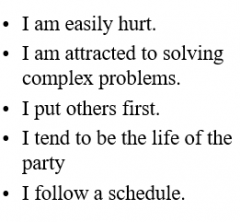
EXAMPLE. if rated "very accurate" on the following statements which of the five major facets of personality is the individual |
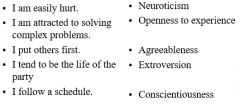
|
|
|
Five factor model traits |

|
|
|
How do our personality traits change as we age? |
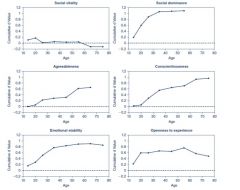
1.Tend to be stable throughout life, but are reliable changes. 2. increases in agreeableness, conscientiousness, and neurotisism in later life 3. openness seems to be fairly stable with slight decrease, same with extroversion |
|
|
Correspondence principle |
People experience particular life events that reflect their personality traits; once these events occur, they further affect peoples pesonalities i.e. someone who is high in extroversion is more likely to be involved in social gatherings than someone who is introverted, therefore growth in extroversion is promoted. |
|
|
Critiques of the 5-Factor Model |
1. circular - shy b/c scared of social abilities. doesn't go out and socialize therefore doesn't grow social skills leads to being even more shy 2. methodological problems - Laypersons identified personality descriptors 3. Doesn't assess core aspects of human nature 4. not predictive of behaviour 5. ignores sociocultural context 6. assumes people can rate their own personality characteristics |
|
|
Midlife crisis theory |
Refers to the period of self-scrutiny and re-evaluation of goals triggered by the individuals entry into middle age. Developed by Levisons and colleagues. Concept largely discounted in academic psychology |
|
|
Critiques of the Mid-Life Crisis theory |
1.Age is not a marker of development: chronological age doesn't relate to personality, ages proposed didn't even agree 2. Levinson's book was highly subjective: seemed interested in studying himself and his colleagues, procedures were never fully published 3. Findings never replicated |
|
|
What was the alternative to the midlife "crisis"? |
Midlife "correction" |
|
|
Levison's Stages of adult development |
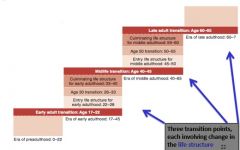
Proposed that development involves primarily changes in the life structure, and that there are 3 transitions in adulthood, with the mid life transition serving as the basis for the mid life crisis |
|
|
Why has the mid life crisis theory stuck, even though its been disregarded in the scientific community? |
Makes a "good story" Exciting to think about change |
|
|
Socioemotional Selectivity Theory |
People become increasingly selective, investing greater resources in emotionally meaningful goals and activities We try to maximize gains and minimize risks in our relationships People focus on emotional rewards as they age, and less on informational rewards in relationships Older people prefer to sepnd time with those who increase those emotional rewards |
|
|
According to the socioemotional selectivity theory, older adults show advantages in...? |
Ability to control, and more effectively express, negative emotions |
|
|
What is the mean age of marriage for men and women in Canada? |
men 31 women 29.6 |
|
|
Describe the Marriage and divorce trends in canada from 1926 to 2006 |
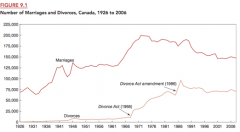
Marriage rates are decreasing, while divorce rates are increasing. Divorce rates saw significant increases in 1968 and 1986, when the Divorce act was introduced and revised. |
|
|
What are the advantages of marriage? |
9-15% reduction in mortality among older adults for married men and women greater happiness and higher quality of life for both partners |
|
|
Has cohabitation preceding marriage increased or decreased in Canada? |
steady increase
|
|
|
Cohabitation effect |
Higher divorce rates among couples who cohabitate before becoming engaged ` |
|
|
Does living together before being engaged increase you're chances of divorce? why or why not? |
No, correlation does NOT equal causation. Although studies have shown that couples who cohabitate before marriage have higher rates of divorce than those who don't, we need to take into account the type of people who are waiting to move in together i.e someone with strong religious beliefs are more likely hold off living together until after marriage, these same people probably don't believe in divorce |
|
|
Divorce proneness |
People who are more likely to contemplate divorce when their marriage is struggling. People in remarriages more likely to consider divorce as an option Remarried people more critical of marriage Higher likelihood that remarried people had family problems in their early years |
|
|
What year did Canada legalize same-sex marriage? |
2005 |
|
|
Name the 11 countries in which same-sex marriage is considered legal |
Canada,Belgium, Norway, Spain, the Netherlands,Sweden, South Africa, Iceland, Argentina, Portugal, Denmark |
|
|
What are the psychological effects of divorce? |
Lower well-being and health (substance abuse) Higher mortality More mental health problems Less satisfying sex life More negative life events |
|
|
Why can divorce statistics be misleading? |
50% rate not based on same couples - those who got married were not the same people who got divorced in a year Divorce proneness increases apparent odds - some people get divorced more than once, inflates stat |
|
|
Risks for divorce |
Immaturity: age of marriage Lack of homogamy: similarity of goals Lack of equality: exchange theory, partners need to perceive fair exchange across relationship |
|
|
Gender differences in adjusting to divorce |
Men: more likely to be surprised by divorce, more likely to be blamed, more likely to be depressed initially Women: more likely to file for divorce, have greater difficulty forming new relationships (custody reasons), greater risk of financial troubles |
|
|
What is the average age of the widowed population? |
75 |
|
|
Widowhood effect |
Greater probability of death in those who have become widowed than in those who are married. Increased mortality due to depression, psychosocial stress, chronic economic hardship, and loss of social support and environmental resources |
|
|
How do the actual fertility rates in Canada compare to the rate needed to sustain the population? |
actual = 1.6 children per woman needed = 2.1 children per woman |
|
|
What does Canadas fertility rates mean for the overall population? |
Our population is aging rapidly |
|
|
How do characteristic of new mothers over the age of 30 differ from those younger? |
More: likely to breast feed, affectionate and sensitive to child's needs, time spent with baby Less likely to: regard birth as mistimed, smoke while pregnant Over 35: more likely to seek fertility treatment Over 40: have higher chances of multiples and complications |
|
|
At what maternal age do we significant increase in risk of down syndrome? |
35 |
|
|
What are predictors of a woman's dissatisfaction during the transition to parenthood? |
1. younger age, non-white ethnicity, short relationship duration prior to pregnancy 2. poor relationships with own parents 3. unplanned pregnancy 4. impulsivity 5. greater centrality of work 6. newborns who are female or with difficult temperaments 7. psychological characteristics (i.e neuroticism, insecure attachment style, psychological disorder) |
|
|
How do different living situation affect family relationships/ dyanmics? |
Single parent families: frustration, guilt and ambivalence about child. mothers often struggle with finances, fathers struggle more with emotion Same-sex families: no difference in adjustment, no differences in sexual identity issues, gay men tend to be more concerned about nurturing, lesbian mothers greater parenting awareness skills
|
|
|
Transition to Parenthood (TtP) |
Period of adjustment to the new family status represented by the presence of a child in the home |
|
|
"Doing gender" |
Refers to the tendency for women and men to behave in stereotypically gendered ways, allocating household tasks towards more traditional roles. This can cause marital dissatisfaction, due to problems with role equity |

